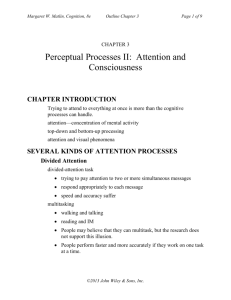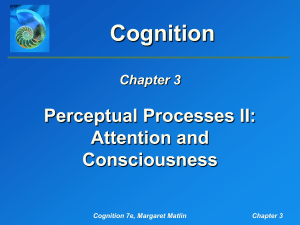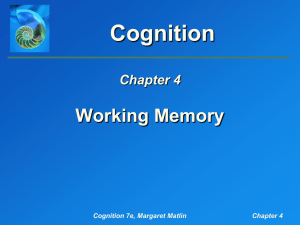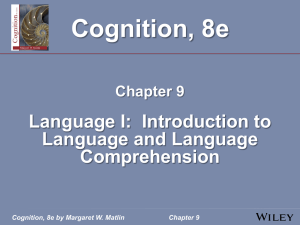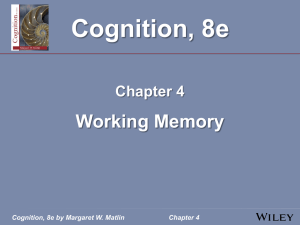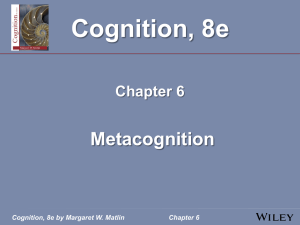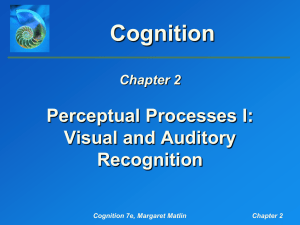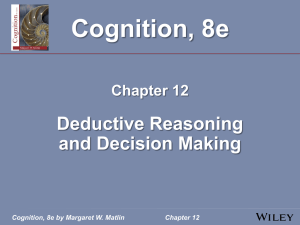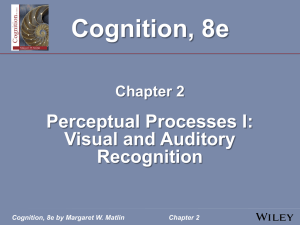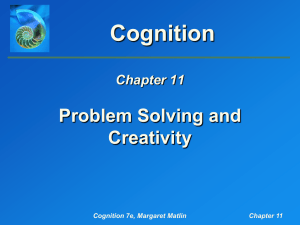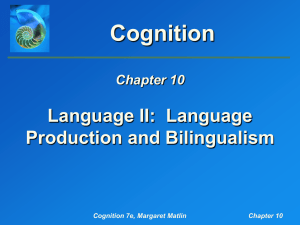Matlin 8e ch3 edited
advertisement
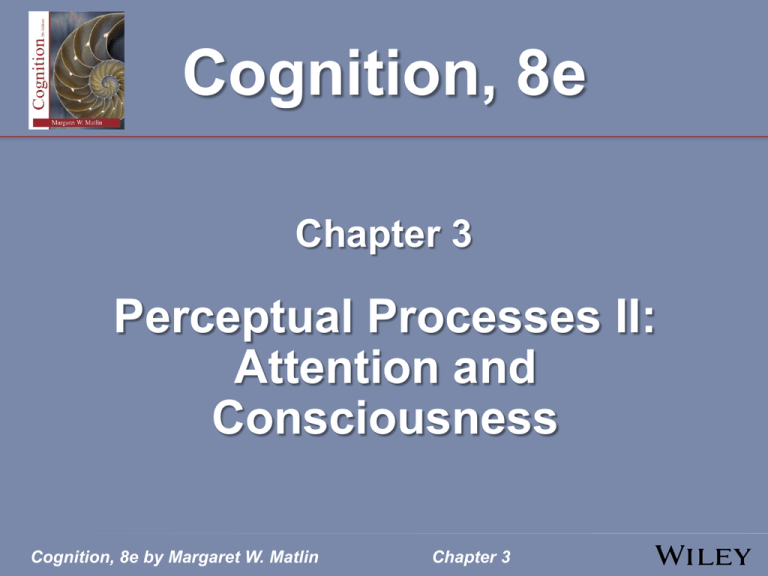
Cognition, 8e Chapter 3 Perceptual Processes II: Attention and Consciousness Cognition, 8e by Margaret W. Matlin Chapter 3 Chapter Introduction • Trying to attend to everything at once is more than the cognitive processes can handle. • attention—concentration of mental activity • top-down and bottom-up processing • attention and visual phenomena Cognition, 8e by Margaret W. Matlin Chapter 3 Several Kinds of Attention Processes Divided Attention divided-attention task • trying to pay attention to two or more simultaneous messages • respond appropriately to each message • speed and accuracy suffer Cognition, 8e by Margaret W. Matlin Chapter 3 Several Kinds of Attention Processes Divided Attention multitasking • walking and talking • reading and IM • People may believe that they can multitask, but the research does not support this illusion. • People perform faster and more accurately if they work on one task at a time. Cognition, 8e by Margaret W. Matlin Chapter 3 Several Kinds of Attention Processes Divided Attention driving studies Collet and coauthors (2011) • handheld cell phone while driving • reaction times during driving are 20% slower than without the cell phone Strayer and colleagues (2003) • hands-free cell phones, traffic • slower to brake • inattentional blindness passenger conversations task switching Cognition, 8e by Margaret W. Matlin Chapter 3 Several Kinds of Attention Processes Selective Attention Overview • pay attention to certain kinds of information, while ignoring other ongoing information • simplifies our lives • People notice little about the irrelevant tasks. Cognition, 8e by Margaret W. Matlin Chapter 3 Several Kinds of Attention Processes Dichotic Listening • a selective-attention task • one message presented to left ear and a different message presented to right ear • shadow one of the messages • People notice very little about the unattended message. Cognition, 8e by Margaret W. Matlin Chapter 3 Several Kinds of Attention Processes Dichotic Listening In general, people can process only one message at a time. However, people may process the unattended message when: 1. both messages are presented slowly 2. the task is not challenging 3. the meaning of the unattended message is immediately relevant Cognition, 8e by Margaret W. Matlin Chapter 3 Several Kinds of Attention Processes Dichotic Listening cocktail party effect Cognition, 8e by Margaret W. Matlin Chapter 3 Several Kinds of Attention Processes The Stroop Effect a selective-attention task Demonstration 3.1: The Stroop Effect • naming the ink color of words • incongruent words vs. colored patches • People take a long time to name the ink color when that color is used in printing an incongruent word; in contrast, they can quickly name that same ink color when it appears as a solid patch of color. Cognition, 8e by Margaret W. Matlin Chapter 3 Demonstration 3.1: The Stroop Effect, Part A Say out loud the names of the ink colors, ignoring the meaning of the words. Measure the amount of time it takes to go through this list five times. Record that time. Cognition, 8e by Margaret W. Matlin Chapter 3 Several Kinds of Attention Processes The Stroop Effect explanations in terms of PDP and practice reading as automatic process Cognition, 8e by Margaret W. Matlin Chapter 3 Several Kinds of Attention Processes Visual Search • a selective-attention task • find a target in a visual display with numerous distractors Variables Influencing Visual Search more accurate if the target appears frequently Cognition, 8e by Margaret W. Matlin Chapter 3 Several Kinds of Attention Processes Visual Search Variables Influencing Visual Search Treisman studies 1. The isolated-feature/combined-feature effect. Demonstration 3.2: Treisman and Gelade (1980) searching for blue Xs Cognition, 8e by Margaret W. Matlin Chapter 3 Demonstration 3.2 Part A First, look at the two figures below. In each case, search for a blue X. Notice whether you take about the same amount of time on these two tasks. Cognition, 8e by Margaret W. Matlin Chapter 3 Demonstration 3.2 Part B Look for the blue X in each of the two figures below. Notice whether you take the same amount of time on these two tasks or whether one takes slightly longer. Cognition, 8e by Margaret W. Matlin Chapter 3 Several Kinds of Attention Processes Visual Search Variables Influencing Visual Search Treisman studies 1. The isolated-feature/combined-feature effect. (continued) If the target differed from the irrelevant items in the display with respect to a simple feature such as color, observers could quickly detect the target. When the irrelevant items force you to search for a combination of features (both blue and X), visual search takes longer. Cognition, 8e by Margaret W. Matlin Chapter 3 Several Kinds of Attention Processes Visual Search Variables Influencing Visual Search Treisman studies 2. The feature-present/feature-absent effect. Demonstration 3.3: Treisman and Souther (1985) searching for "circle with the line" or "circle without the line" People can typically locate a feature that is present more quickly than a feature that is absent. Cognition, 8e by Margaret W. Matlin Chapter 3 Cognition, 8e by Margaret W. Matlin Chapter 3 Several Kinds of Attention Processes Visual Search Variables Influencing Visual Search Royden and colleagues (2001) People can quickly locate one moving target when it appears in a group of stationary distractors. In contrast, they take much longer to locate one stationary target when it appears in a group of moving distractors. It’s easier to spot a movement-present object than a movement-absent object. Cognition, 8e by Margaret W. Matlin Chapter 3 Several Kinds of Attention Processes In Depth: Saccadic Eye Movements During Reading • a selective-attention task • eye movements important in looking, searching, driving, speaking, and reading saccadic eye movement • series of little jumps of the eye • bring the center of the retina (fovea) over the words being read Cognition, 8e by Margaret W. Matlin Chapter 3 Several Kinds of Attention Processes In Depth: Saccadic Eye Movements During Reading fixation perceptual span patterns—The eye usually moves past blank spaces, short words, and highly predictable words, but the eye usually pauses for misspellings, unusual words. Cognition, 8e by Margaret W. Matlin Chapter 3 Several Kinds of Attention Processes In Depth: Saccadic Eye Movements During Reading good readers vs. poor readers—size of saccadic movements, regressions, pauses Cognition, 8e by Margaret W. Matlin Chapter 3 Explanations for Attention Theories of Attention Early Theories of Attention Bottleneck theories • narrow passageway • information either passes through bottleneck or is lost • too simple; underestimate flexibility • information not lost at just one phase of the attention process Cognition, 8e by Margaret W. Matlin Chapter 3 Explanations for Attention Theories of Attention Feature-Integration Theory (Anne Treisman) 1. The basic elements distributed attention focused attention register features automatically slower serial processing parallel processing identify one object at a time identify features simultaneously complex objects low-level processing identify which features belong together Cognition, 8e by Margaret W. Matlin Chapter 3 Consciousness Three Interrelated Issues 1. our inability to bring certain thoughts into consciousness 2. our inability to let certain thoughts escape from consciousness Cognition, 8e by Margaret W. Matlin Chapter 3 Consciousness Consciousness of our higher mental processes • mindless reading • mind wandering Nisbett & Wilson (1977) little direct access to our thought processes products vs. processes Cognition, 8e by Margaret W. Matlin Chapter 3 Consciousness People have relatively complete access to some thought processes, but only limited access to other thought processes. Cognition, 8e by Margaret W. Matlin Chapter 3 Consciousness Thought Suppression thought suppression—the attempt to eliminate thoughts, ideas, and images related to an undesirable stimulus Demonstration 3.5: Do not think about a white bear! ironic effects of mental control Cognition, 8e by Margaret W. Matlin Chapter 3 Consciousness Blindsight vision without awareness damage to visual cortex can still identify some visual attributes of stimulus reported as "not seen" (no conscious awareness of object) Cognition, 8e by Margaret W. Matlin Chapter 3 Consciousness Blindsight Possible explanation • A small portion of the information from the retina travels to other locations on the cerebral cortex, outside the visual cortex • Some characteristics of the visual stimulus may be identified by information registered in other cortical locations. Cognition, 8e by Margaret W. Matlin Chapter 3 Consciousness Blindsight Possible explanation (continued) • Primary visual cortex is necessary for conscious awareness of visual information. • Perception of the stimulus (without conscious awareness) may be possible. Cognition, 8e by Margaret W. Matlin Chapter 3
